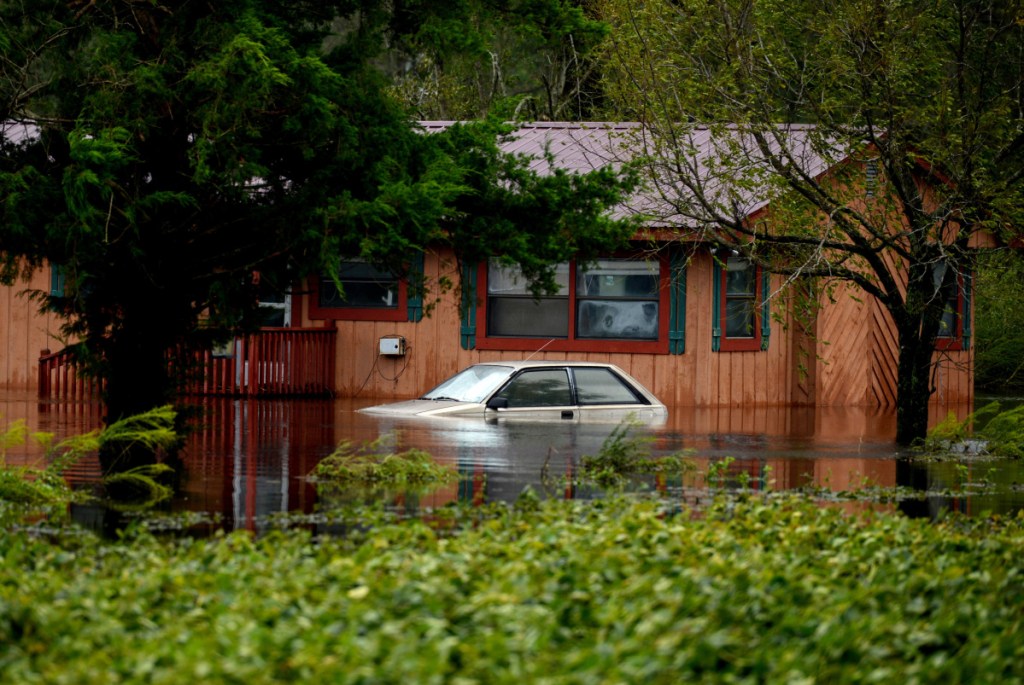In coming weeks, long after Hurricane Florence’s winds and rains have faded, its aftermath will still pose life-threatening hazards: snakes, submerged sharp objects, bacterial infections and disease-carrying mosquitoes.
People are trapped by floodwaters and facing dwindling supplies of medicines, food and drinking water. Carbon monoxide poisoning is a danger as people crank up portable generators, and respiratory viruses will circulate in crammed shelters.
On Monday morning, in Maxton, North Carolina, Dan Lowry, 48, and his wife, Jewel, 51, trudged through the waist-high water around Dan’s father’s house, aware of the dangers around them.
“Yeah, there could be bacteria,” Dan said. “Or snakes.”
Both were wearing shorts. Their feet were bare. The sun had finally broken through the clouds, and they were going to check on their trailer, in the backyard.
Beside him, his wife shrugged in resignation. “What are you going to do?” she said.
Disaster experts categorize health hazards in the wake of disasters as short-term, midterm and long-term dangers.
The majority of people who die during or immediately after a storm die by drowning.
Missing manhole covers and storm drains can become sudden hazards.
“When the water on the street is three or four feet deep, those drains can be active, sucking hundreds of gallons of water a second, and you won’t see anything on the surface,” said David Persse, Houston’s public health officer and head of emergency services. Years ago, he said, a teenager was pulled into a drain and died.
“People see their neighbors floating in kayaks and small boats and think, ‘How can the water be dangerous? It looks just like a lake,’ ” Persse said. But that water is often a toxic chemical stew of all the organic matter people have flushed down their toilets and sinks, along with the contents of cleaning supplies under their sinks and paint cans and chemicals from their garages. Hurricane Katrina in 2005 sent exhumed corpses floating through neighborhoods in New Orleans.
EPA officials Monday described a near miss after a train hauling chemicals derailed near the border of North and South Carolina. The chemical inside, butanol, did not spill, but diesel fuel from the train did, gathering in a low-lying area. Manure and other agricultural runoff from animal farms are a concern, as well as coal ash storage pits.
Another immediate concern is getting medication and treatment to people with chronic illnesses.
Speaking by phone Sunday night from the parking lot of a dialysis center in North Carolina, Tom Cotter, state team leader for the relief group Americares, said he was waiting for more than 100 dialysis patients being transported by bus who had been rescued from flooded homes in Jacksonville, 90 miles to the south. Some hadn’t gotten treatment for their kidneys for as long as five days because of the storm.
“This is very much an ongoing disaster,” Cotter said.
In the medium term, disease is a major concern.
At a shelter in Lumberton, North Carolina, Makoma Patahalla recalled the last time he lived through a big storm, Hurricane Matthew in 2016. After wading through waist-high murky water and getting picked up by a rescue crew, he had painful, inexplicable sores on his arms and legs.
“I got contaminated by something,” he said. A doctor gave him an ointment to treat the sores, but they were never diagnosed. That’s why he decided to take refuge at a high school this time before the rain even started. He didn’t want to wade through the dark, soupy floodwater again.
After Hurricane Harvey in Houston last year, residents saw an increase in upper respiratory infections and skin rashes.
After Hurricane Maria in Puerto Rico, the number of cases of a rare bacterial disease known as leptospirosis increased from dozens of cases a year to the low hundreds.
The bacteria is carried by animals such as rodents, raccoons, cattle and pigs. People get infected through cuts in the skin, or the bacteria getting in their eyes or mouth, said Ilana Schafer, a Centers for Disease Control and Prevention veterinary epidemiologist.
Most patients have a mild flulike illness, but some become severely ill, developing kidney and liver failure and, in rare cases, dying.
After extensive flooding in Louisiana in 2016, state health officials discovered two patients hospitalized with severe leptospirosis.
Send questions/comments to the editors.



Success. Please wait for the page to reload. If the page does not reload within 5 seconds, please refresh the page.
Enter your email and password to access comments.
Hi, to comment on stories you must . This profile is in addition to your subscription and website login.
Already have a commenting profile? .
Invalid username/password.
Please check your email to confirm and complete your registration.
Only subscribers are eligible to post comments. Please subscribe or login first for digital access. Here’s why.
Use the form below to reset your password. When you've submitted your account email, we will send an email with a reset code.